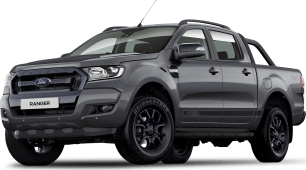It’s just like the regular HiLux. Funny, that…
There are no significant changes to the hardware - the drivetrain is the same, the steering is the same, the brakes are the same. Only the Rugged and Rugged X versions get new front springs to help deal with the extra weight of the bullbar and underbody protection.
We spent a lot of time driving on outback highways, with the odd small town (Hawker, Parachilna, Port Augusta) the only urban interludes. On roads like these you’re not typically asking much of the engine, and that was the case here.
When it came to overtaking moves I found out what the 2.8-litre turbo-diesel and six-speed automatic was about. In Eco mode it’s a bit gutless (adding an extra 200 kilograms of bolt-on bits will do that), but in normal or Power mode, the drivetrain is willing and punchy enough.
In the past I’ve found the auto can be a bit fussy at low speeds, in particular when you’re applying the brakes while going down a hill. However, for the most part, the drivetrain is perfectly suitable for this application.
Hey, a bigger engine - or even just a tweak to the outputs - would have been welcome for these special new additions to the range, but if you want a more torque-laden drive, you ought to look at the Ford Ranger, Holden Colorado or Volkswagen Amarok.
Underpinning the HiLux is double wishbone front suspension and leaf-spring rear suspension, and I have to say, the ride is terser than many rivals with nothing in the tray - and the slower you go, the worse it is.
However, as I’ve found, a few kilos in the tub will settle things nicely. Just be careful how many kilos, because the payload is pretty low in these new hardcore models - in fact, the heaviest model, the Rugged X, felt probably the most settled on the road.
As for steering, the hydraulic power steering is pretty well sorted, with good weighting and nice response. It isn’t as quick or easy to twirl as a Ranger, but nor is it as heavy as, say, a BT-50, or as slow as a Navara or X-Class… it’s a nice middle ground.
The 17-inch alloy wheels of the Rugged and Rugged X models alloy buyers to easily change to more aggressive all terrain or mud terrain tyres if they want to upgrade, while the 18s of the Rogue model would more likely see replacement with 20s, or 22s, or who knows… Just a shame it misses out on those wheel arch extensions.
Now, for the off road review - that was a big focus on the launch, particularly for the Rugged X - and I was certainly able to get an idea of its capabilities. If there was a separate section, it’d be at least an 8/10. Maybe even a 9/10.
The extra kit has had an impact on ground clearance - surprisingly, all three new models have less ground clearance mm than the SR5 dual cab. That model has 279mm, where according to Toyota the Rogue has just 216mm, while the Rugged has 253mm and the Rugged X 251mm.
The wading depth mm remains the same - 700mm - but approach and departure angles have changed. Again, the regular SR5 has a 31 approach angle degrees, where the Rugged and Rugged X models have 28, and Rogue has 30.
However, the big improvement according to Toyota is the corner approach angle: it sits at 39 degrees for the Rogue, 45 for the Rugged and 49 for the Rugged X.
The departure angle degrees has changed, too, due to the standard-fit tow bar: it’s 21 degrees for the Rugged and Rugged X, and 20 degrees for the Rogue. The standard SR5 with no bar is 26 degrees.
When you’re off-roading, the turning circle is also important: it’s identical for the three new models (and the existing models) at 12.6 metres. That’s pretty large - but the steering response and feel is impressive off-road.
Thankfully there’s less chrome to clean on these new models, because off-roading is a lot of fun in them.
We went on some 4H high-range-friendly gravel roads, which is where Toyota’s local engineering efforts with the HiLux shines through most. It remains settled and comfortable even if the surface gets rutted and rough.
We also did a more hardcore 4L low-range test, which included giving the rock rails a workout by intentionally pivoting on the edge of a boulder on a course set up by Toyota, and also found out the angles are pretty impressive first hand. Unfortunately there was no water in the river to verify the wading depth and ability of the snorkel. And yeah, there’s a rear differential lock in all models, but we didn’t need it - the same can be said for the hill descent control (which is reserved for the SR5-based Rugged X and Rogue).
Shame the Rugged model doesn’t get the same leather steering wheel as the Rogue and Rugged X. It’s a much nicer thing to hold.
It’s decent to drive, but not the best in class. And we’d have to put it against some competitors to see where it sits, but those after city-friendly comfort should still consider the Ranger and Amarok over this ute.
































